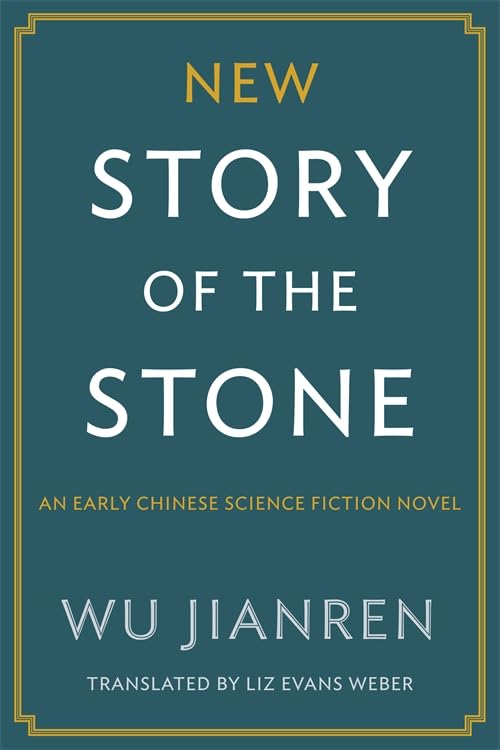New Story of the Stone by Wu Jianren is one-part fan fiction, one-part historical fiction, and one-part science fiction. A full translation by Liz Evans Weber gives English-language readers access to the early 20th-century novel and a fascinating perspective on a moment in China’s history that speaks volumes about its present and possible futures.
The original Story of the Stone is that great 18th-century novel also known as Dream of the Red Chamber. It is the story of Jia Baoyu, the scion of a wealthy clan with a magnificent garden, wherein Baoyu spends his happiest days enjoying poetry and other pleasures with his female relations. As the translator concisely explains in her helpful introduction, Wu Jianren was not so much a “fan” of the original, but a critic. In writing a self-consciously modern sequel, Wu places Baoyu in the China of his present—a China in crisis—and has his famous protagonist take up “more respectable pursuits”. Wu transforms Baoyu, who is a bit of a dreamer and romantic in Cao Xueqin’s original, into a staunch Chinese nationalist, who is interested in science and politics, and skeptical of certain foreign goods and foreign intentions.
As Baoyu awakens from a long slumber of over a century at the beginning of the novel, some of the most amusing moments of the book involve his adjustment to a changed world. For instance, on a steamship to Shanghai, he encounters toast:
… he saw Xue Pan pick up one of the little cakelike squares, smear it with a purplish-black sauce, and eat it.
Unable to restrain himself, Baoyu asked, “What’s that thing you’re eating?”
Xue Pan replied, “It’s a mantou that’s been sliced apart and roasted. The Shanghainese call it by a transliterated word from a foreign language: tuoshi.”
The passage gives a good sense of how fun the book can be, and how challenging it must have been for the translator, who skillfully renders tricky passages, though much is lost in the translation of some of the puns.
In Shanghai, Baoyu tours the Jiangnan Arsenal, debates foot binding, listens to political speeches, studies English, and expounds on principles of economic nationalism. For the contemporary reader, it is a window on urban China in the final decade of imperial rule. But even in Wu’s time, the book was a platform for discussion of recent historical events, particularly the Boxer Uprising. Baoyu is caught up in that affair during a trip to the north, giving Wu the chance to paint a picture of China’s abject position during its occupation by the Eight-Nation Alliance in 1900.
The subservience to foreign military might that Baoyu witnesses after the Boxer affair recedes like a bad dream once we arrive in the second half of the novel, which takes place in “the Realm of Civilization”. Baoyu has not, once again, slumbered his way into the future; he has simply arrived in a futuristic alternative China that somehow coexists with the China-in-crisis of the early 20th century. In this alternative China, one can be nourished and sated while only consuming liquids, drink alcohol without getting drunk, ride flying cars, travel through subterranean tunnels, walk through a winter wonderland in the summer, and hunt the beasts of sky and sea with the most advanced military technologies, all under the benevolent rule of an authoritarian emperor, who has overcome the failings of parliamentary factions simply by cherishing the people. In this China, the great minds are on the cusp of defeating death. A learned practitioner of the medical arts explains:
I believe that after we have mastered a technique to prevent death, we will cease to produce offspring. If you don’t believe me, all you need do is read the books passed down from antiquity which tell of the immortals and Daoists—when do they ever tell of immortals or Daoists having children?
Reading this I felt, not for the first time, that the Realm of Civilization is really a dystopia.
New Story of the Stone is instructive, historically evocative, creative, and unlike anything I have read before. Wu’s Realm of Civilization gave me insight into more recent works of Chinese science fiction, with their themes of rapid change and civilizational competition. But reading New Story as a novel, a form of prose one hopes to enjoy, I couldn’t help but find it deeply unlikeable. I was repelled by the characters and the novel’s underlying values, its cultural chauvinism, hyper-rationalism, praise for authoritarian government, casual sexism, and overt racism toward “the red, black, and brown races”. I could read the novel on its own terms, placing it in its historical context, but that didn’t enhance my enjoyment.
At one point in the Realm of Civilization, Baoyu joins a hunting trip that takes down a mighty bird, somewhere over Africa, with poisoned bullets shot from a flying car. The hunting party wraps the carcass in a net made of platinum threads to haul it back to the museum, an icon of modernity and scientific thinking in the author’s time. The museum director exclaims,
Why, it’s the peng bird that Zhuangzi spoke of! … It is the transformation of the great kun fish. If you don’t believe me, just look at its claws: it still has scales there. Our avian creatures exhibit was missing only this single specimen.
The mythical peng, a symbol of “the vastness and unknowability of the universe”, as Weber puts it in an endnote, has been subdued and classified, bringing esteem to the hunters and the realm. But I think Wu Jianren, and his readers, me included, are really like the small birds and the cicada of Zhuangzi’s parable; beings who speak with great certainty about the value of their own experience, though they cannot begin to fathom the limits of what they know.

